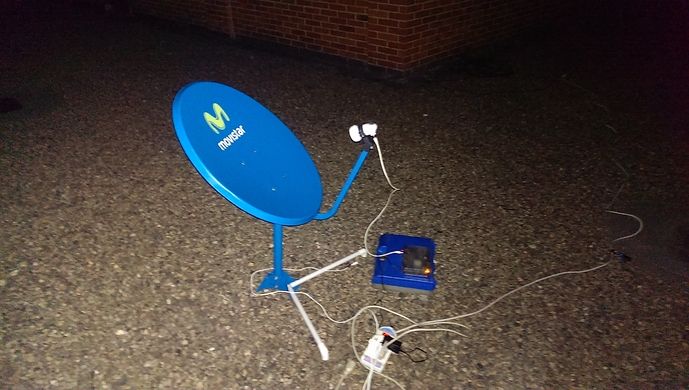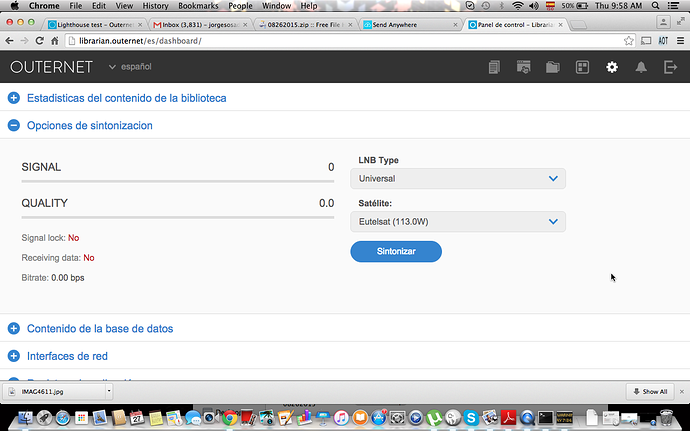Can you email us the sytem logs as well as application logs?
It appears you are using North America Ku band LNB in the settings. You should be using Universal, based on the photo you posted.
We have tested with both but it doesn’t connect
Do you have a regular satellite TV set-top box to test if you receive anything at all from Eutelsat?
Also, can you log in via SSH, and do this:
sudo su # password: outernet
/etc/init.d/S80ondd stop
ondd -f 1489 -s 11719 -p H -t -V -i -o /mnt/data/ | tee /mnt/data/downloads/files/ondd_test.txt
Let it run for around 30 seconds, and then stop with Ctrl-C. You can download the ondd_test.txt file from the Files section or scp it to your computer.
We have made a new test with your suggestions, unfortunately we do not have a TV set-top box. Still, no luck. We tried to collect as much information as we could so that you can help us.
Installation
We used an android app to locate the eutelsat 113w satellite and point towards it
Configuration
Logs
Here you can see application logs, systems logs as well as the output of the test you sent me.
Jorge,
To see your picture, I have the feeling, your dish havenot a correct elevation. I dont know what is your location, but if you put your city-s name and your street address, and the name of the sat you want to points in this web page:
you will get 2 main values:
One for the elvation. This is the direction in grads, where you will see the geostats satellites “belt” from your location.
And this is the direction, where you can pull up your dish, more exactly its “main axis”. You can imagine, where it this axis is, and you can measure this elevations from the horizontal line/water level. On your picture it seems me this direction is too high. For a rough check, you can look around, find another dishes, and you can check theirs approx directions/elevations.
If you find this elevation, where there exist the satellites, you can deal with the second calculated value at the dishpointer site, this is the azimut value. If you fill the form with your exact location, you can see on the web site the exact diretion pojected to the google map of your location. If you have an iPhone, its compass application you can find easy this direction in the real situation.
t.janos
hola
the movistar dish of 60 cm it is very small
you better use 65 cm o 90 cm dish
I also have problems tuning 113w with a 60cm dish , It does not give sufficient strength.
here some pics outernet | Flickr
saludos
Jorge, can you give us your location’s elevation in degrees? Looking at your dish, you must be near the equator, and the sat virtually overhead.
You have an offset dish, so the angle to the satellite is not the same as the direction of the dish. Below hopefully helps.
Yellow is a line perpendicular to the dish, red is the direction to the satellite. Some dishes take the offset into account, and the markings on the elevation axis directly correspond to your elevation from the equator. It is only a couple of degrees from maximum to nothing.
I don’t think smartphone apps are accurate enough. You can use it to get the rough direction, but a satfinder will give you much better indication of correct pointing.

IMHO, if you are virtually under the satellite, a 60cm dish should suffice, but try to find a footprint diagram for 113W, which gives EIRP (power level) to dish size correlation. Generally, the further you are from the centre of the footprint, the bigger dish you need.
Will this do?
EDIT: Incidentally, it seems according to Satbeams, the minimum size is 65cm in general.
Branco, that’s a good website. I have not seen it before. I used this page to look up HB 13E
It seems EIRP to dish size is not an exact science, given that the sizes overlap. I would err on getting a 80cm just to be on the safe side, but without knowing jorge’s AZ and EL, its hard to guess. I’d say 60cm would be OK, if marginal.
The link for 113W, at 49dBW recommends 65cm, where for 13E, at 49dBW, recommends 55-65cm
I agree with @JohnSpace; it’s always best to add 10cm to whatever is recommended by the various EIRP sites.
@jorge: What is your location?
FTR at my location, Satbeams says I need a 90cm dish for IS-20 (44.8 dBW), but in reality, nobody could lock it even with a 120cm dish. I’m assuming that SatBeams formula doesn’t take into account location-specific factors such as elevation.
hi
i found this tools but do not work for me
http://www.eutelsat.com/deploy_SorbamLight/pages/azimuthElevation.do?action=calculate
Thank you very much everyone for all the information, I am in Bogota, Colombia South America. we have contacted a directv technician an he has indicated the same thing you are telling us. we need a bigger dish as the satellite is very far. And he has told us, that even if we have a bigger dish, it still will not be an easy task. We have used the same website as kalashnikov(http://www.satbeams.com/footprints?lat=4.687502&lng=-74.068161&zoom=1&beam=5528&type=normal&name=oficina). And we have decided to buy a 90 cm dish, and it will arrive today. We will make tests and hopefully it will work. We will keep you posted on any update.
I’m glad we’re on to the problem now. Please be sure to let us know how it goes.
im not jorge, i live in colombia too …
for tv i use amazonas 61w (60 cm dish) and hispasat 30w (65 cm dish)
here amzonas footprint SatBeams - Satellite Coverage Maps - Sat Footprint Amazonas 2 (AMZ2) / Amazonas 3 (AMZ3) / Amazonas 5 (AMZ5) / Echostar 15 / Echostar 16 (Echostar XVI) / Echostar 18 (EchoStar XVIII, USABSS-41) , I think the data from this site are not truthful
@Syed yes, what kalashnikov says is true, amazonas is directv, Also claro has just launched Star One C4 SatBeams - Satellite Coverage Maps - Sat Footprint Star One C4 (Hispasat 70W-1, H70W-1) / Star One D2 / Viasat 2 (VS-2)
I’d be surprised if elevation (above sea level) is having that effect. Perhaps they have turned power down in the transponder. I will ask my guru tomorrow.

